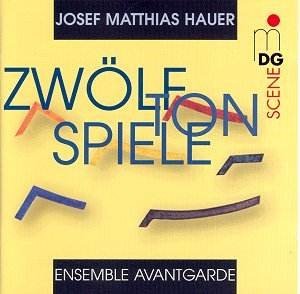Less than fifty minutes on a disc may seem short measure,
but when the time is stuffed full of little discoveries, as this disc
is, the rewards are long lasting indeed. The name of Hauer is more often
found in text books than in concert hall programmes, and if this disc
is anything to go by this neglect is hopelessly unfounded. His discography
is woefully small. Some piano pieces are played by Herbert Henck on
Wergo WER6609-2, some are played by Elizabeth Klein on ClassicO CLASSCD176
and (amazingly) there is a complete performance of his opera Salammbo
on Orfeo (a live account from 1983 conducted by Lothar Zagrosek on Orfeo
C493981A).
Perhaps it is unfortunate that Hauer is best known
for his dispute with Schoenberg as to who had the idea of the twelve-tone
system. He was a curious man who in his time even formed the model for
the Magister Ludi in Hermann Hesse’s Glass Bead Game (incidentally,
a truly inspirational book: if you have not read it, I suggest you do).
From 1939, all of Hauer’s works were called Zwölftonspiele
but not numbered so they appear as only, for example, Zwölftonspiel
for piano (New Year 1947), or Zwölftonspiel for flute and
harpsichord (August 31st, 1948). This is hardly ideal (apparently
there are literally thousands of them), but there remains as yet no
catalogue of his works. Although the majority are for piano, piano duet
or harpsichord, other instruments and combinations appear and it is
with one of these combinations that the MDG disc begins - for ‘home’
orchestra: Zwölftonspiel for violin, cello, accordion and piano
four hands (October 1957). It is true to say that this is curiously
and deliberately inexpressive music (Hauer’s own instructions for performance
are an unhelpful, ‘not too fast, not too slow, not too loud, not too
soft; well-tempered, well-intoned’).
Right. No problem, then.
Well, actually, there is, for there is no performance
tradition for the Ensemble Avantgarde to call on, and the booklet notes
tell of much discussion/argument in rehearsal as to how to actually
present these pieces. What’s more, they all apparently follow the same
model: a twelve note row is stated and then set out in four parts, undergoing
contrapuntal exploration (although this appears not to happen in all
of the pieces on the disc: Zwölftonspiel for violin and piano)
has the piano in distinctly accompanimental mode against the more obviously
solo violin). The fact is that the uniformity of title belies the variety
contained therein, both within and between pieces. What is for sure,
though, is that the juxtaposition of ‘play‘ and twelve-note manipulation,
which may at first appear anachronistic, actually provides incredibly
fertile ground for the seeds of Hauer’s imagination.
The first track, the above-mentioned Zwölftonspiel
for home orchestra for home orchestra: violin, cello, accordion and
piano four hands (October 1957) presents a bizarre sound, instantly
Viennese (although the Vienna of the turn of the century Second Viennese
School). Some pieces come across as disembodied fragments: Zwölftonspiel
for violin and harpsichord (August 26th, 1948) is just 58 seconds,
for example, and the Zwölftonspiel for solo clarinet (1947),
base on a twelve-tone row by Ernst Hartmann, is 1‘05 of Matthias Kreher’s
superb clarinet playing. The variety of Hauer’s musical language, even
within the 50 minutes of this disc, is breath-taking and ranges from
the pleasant (Zwölftonspiel for flute and harpsichord)
to the almost Impressionistically-lush-threatening-pre-Glassian-minimalism-at-any-moment
Zwölftonspiel for string quartet (January 1957), to the
capricious XXII. Zwölftonspiel for piano (1946),
to the serious-yet-delicate Zwölftonspiel for piano (New Year
1947) ... the list just goes on ...
Performances are uniformly excellent. Pianist Steffen
Schleiermacher is superb (try any of his John Cage discs on the same
label if you need further proof, or his piano recital of Darmstadt music
on MDG613 1004-2: see my review). He also provides the indispensable
booklet notes. Embedded within the member list of the Ensemble Avantgarde
is the Leipzig String Quartet, which has distinguished itself elsewhere
in Dabringhaus und Grimm’s extensive catalogue.
I am confident this disc will not only retain its fascination
for a long time to come, but that it will encourage me to explore what
little the catalogue has to offer of this remarkable figure. It would
be a heart-warming thought indeed if, in these cash-strapped times for
the recording industry, enlightened companies the like of Dabringhaus
und Grimm could continue where this disc left off and provide more Hauer
discs. They would, indeed, be most welcome.
Colin Clarke


